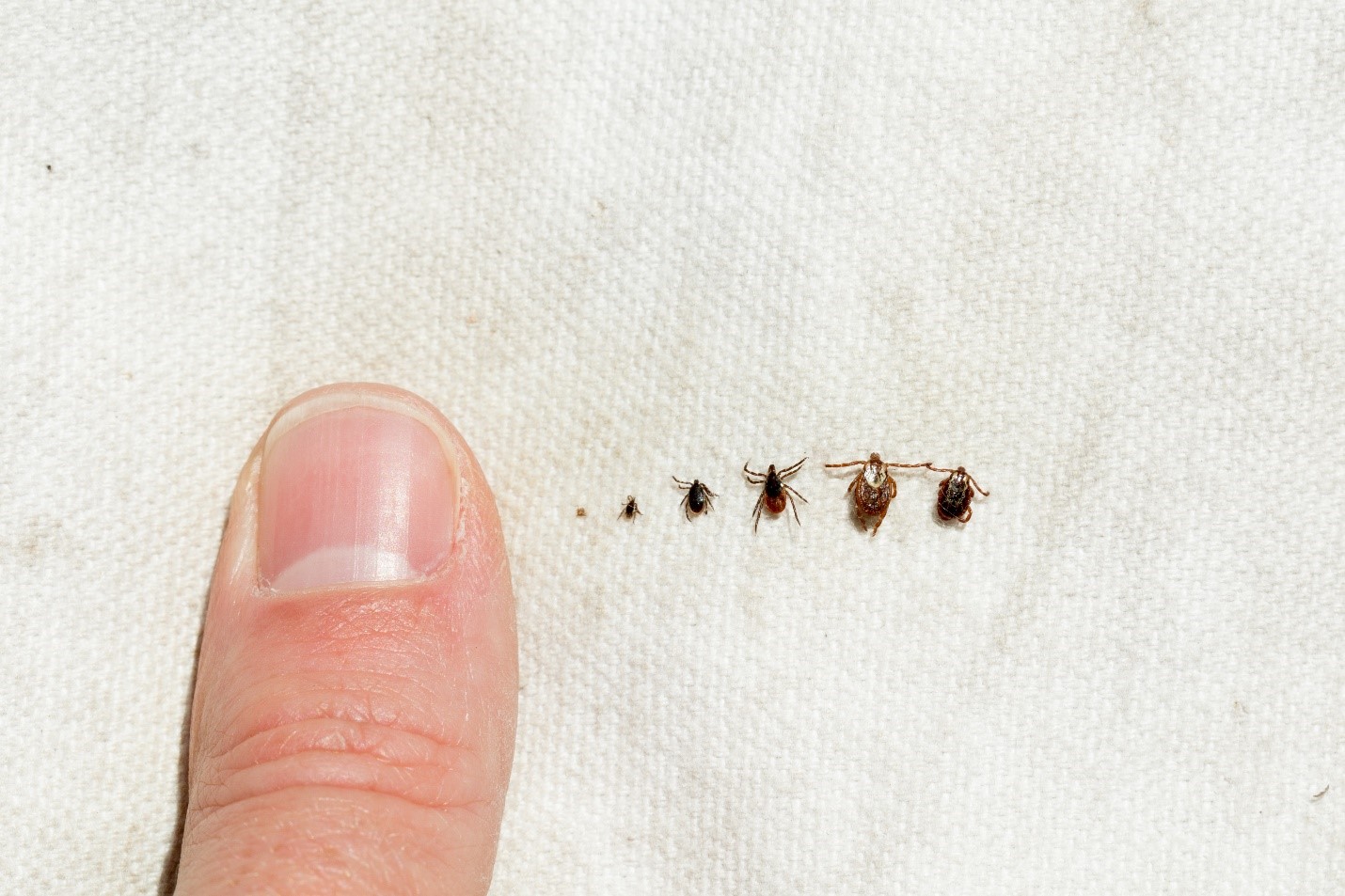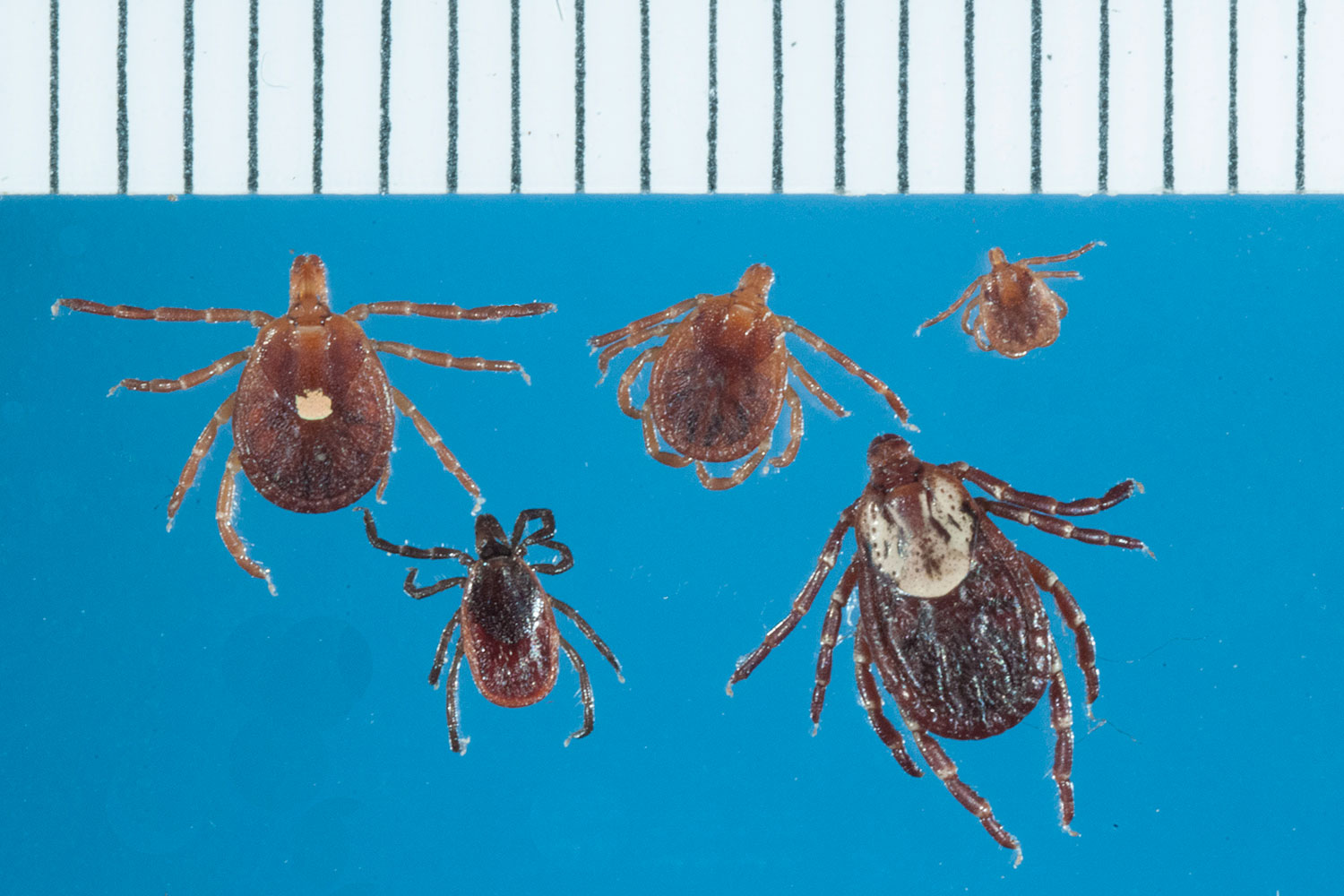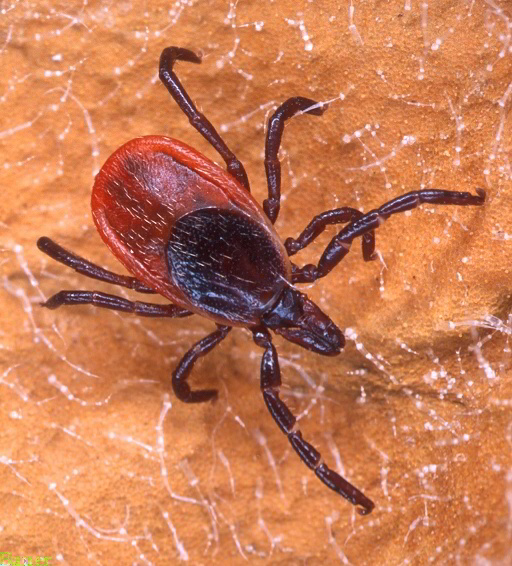Dog Tick Deer Tick Nymph : Hunterdon County Health Department - Press Release
Dog Tick Deer Tick Nymph : Hunterdon County Health Department - Press Release. American dog ticks have white markings on their backs while blacklegged ticks do not (figure 2). Deer ticks are smaller than their counterparts, the dog and lone star ticks. Greatest risk is spring through fall. Ticks become infected when tick larvae and nymphs feed on mice, chipmunks, red squirrels and other small mammals that are reservoirs of several agents that cause diseases in human and domestic animals. Other members of the family include the deer tick, lone star tick, rocky mountain tick, and more.
Ticks become infected when tick larvae and nymphs feed on mice, chipmunks, red squirrels and other small mammals that are reservoirs of several agents that cause diseases in human and domestic animals. Ticks are known to transmit lyme disease, bourbon virus disease, rocky mountain spotted fever, babesiosis, ehrlichiosis, tularemia, texas fever, and powassan encephalitis. Scale of deer tick in centimetres. Deer tick nymphs are very small, about the size of a poppy seed, and can be difficult to see. The highest risk of being bitten by a dog tick occurs.
 Ticks in a line from www.health.state.mn.us
Ticks in a line from www.health.state.mn.us
Deer tick nymphs are typically the size of a poppy seed, 1 to 2 mm (.039 to.078 inches) hard ticks, such as the deer tick, have a scutum or shield covering the body.[6] x research source soft ticks do not have this feature. People best know this species for its spread of rocky mountain spotted fever, though it also spreads tularemia. Learn tips for identifying ticks tick adults lay eggs. They are most active between. Deer ticks are smaller than their counterparts, the dog and lone star ticks. Ticks (suborder ixodida) are parasitic arachnids that are part of the superorder parasitiformes. Having survived the winter, engorged female deer. Blacklegged deer ticks feed on blood by inserting their mouth parts into the skin of a host animal such as a mouse, dog, bird, or even human.
Along with mites, they constitute the subclass acari.
About the size of a poppy seed (1 to 1.5mm), their miniscule size makes them extremely. Dog ticks continue feeding through the late fall. These tick pictures are an adjunct to the paper dealing with deer ticks provided on this site. A female deer tick (left) and a nymph deer tick. American dog ticks do not transmit the disease exposure to blacklegged ticks can occur during the months of april to november with the nymphs being active in the late spring and early summer and. Have you ever felt the gripping, nauseating fear that comes with finding a tick burrowed into your skin? Dog ticks can be harmless, but many transmit disease. Learn about tick bite symptoms, treatment, prevention, and removal of ticks. Deer ticks can carry serious diseases that can be harmful to humans & other animals. Larvae are less than 1 mm long (about poppy seed sized) and. Discover what you need to know to keep yourself and your dog safe and tick free. American dog ticks have white markings on their backs while blacklegged ticks do not (figure 2). A tick ovipositing (laying eggs).
Ticks (suborder ixodida) are parasitic arachnids that are part of the superorder parasitiformes. Adults typically use deer as hosts although they are equally happy with humans, dogs or horses. Courtesy of griffin dill, umaine cooperative extension. Repels and kills ticks including deer ticks (vector of lyme disease), american dog ticks (vector of rocky mountain spotted fever), brown dog ticks controls fleas, mosquitoes, brown dog ticks, blacklegged (deer) ticks andamerican dog ticks for up to 3 weeks.? Deer ticks are smaller than their counterparts, the dog and lone star ticks.
 FS1281: Lone Star Ticks in New Jersey: Risk, Ecology, and Prevention (Rutgers NJAES) from njaes.rutgers.edu
FS1281: Lone Star Ticks in New Jersey: Risk, Ecology, and Prevention (Rutgers NJAES) from njaes.rutgers.edu
Learn about tick bite symptoms, treatment, prevention, and removal of ticks. Along with mites, they constitute the subclass acari. Adults typically use deer as hosts although they are equally happy with humans, dogs or horses. Dog ticks begin searching for their host in april, while new nymphs appear in may. Deer tick nymphs are typically the size of a poppy seed, 1 to 2 mm (.039 to.078 inches) hard ticks, such as the deer tick, have a scutum or shield covering the body.[6] x research source soft ticks do not have this feature. This is a zoonotic disease, meaning. Most people are not familiar with deer ticks and cannot tell a deer tick from a dog tick additional pictures for the deer tick afficianado. Deer ticks are smaller than their counterparts, the dog and lone star ticks.
Along with mites, they constitute the subclass acari.
.see what ticks look like, tick identification, symptoms, pictures & photos of all kinds & types of ticks, including the black legged deer tick, seed etc & advice mccann dog training. They cannot jump or fly. Deer ticks are smaller than their counterparts, the dog and lone star ticks. This video from the maine center for disease control and prevention explains what you need to know about identifying two types of ticks: Deer tick in the spring, engorged females drop off the host animal and lay 3,000 eggs in a protected area. This is a zoonotic disease, meaning. About the size of a poppy seed (1 to 1.5mm), their miniscule size makes them extremely. Dog tick, or wood tick, is a parasite species that feeds on the blood of animals and humans. These tick pictures are an adjunct to the paper dealing with deer ticks provided on this site. Potential transmitters of lyme disease, they are the animal bane of my new england outdoor existence. Within the us, the deer tick it. Nymphs are more likely to spread disease because their small size allows them to feed for longer periods of time without being noticed, increasing the chance of disease transmission. A tick ovipositing (laying eggs).
Within the us, the deer tick it. A smaller tick with a red tint is likely a deer tick, but #4. Learn tips for identifying ticks tick adults lay eggs. Deer tick in the spring, engorged females drop off the host animal and lay 3,000 eggs in a protected area. Make sure to protect you & your family from deer ticks with nymphs:
 American Dog Tick - Dermacentor variabilis - North American Insects & Spiders from www.cirrusimage.com
American Dog Tick - Dermacentor variabilis - North American Insects & Spiders from www.cirrusimage.com
Make sure to protect you & your family from deer ticks with nymphs: A smaller tick with a red tint is likely a deer tick, but #4. Deer tick in the spring, engorged females drop off the host animal and lay 3,000 eggs in a protected area. They will transfer to a potential host when one brushes directly against them and then seek a site for attachment. Have you ever felt the fear? Nymphs are more likely to spread disease because their small size allows them to feed for longer periods of time without being noticed, increasing the chance of disease transmission. People best know this species for its spread of rocky mountain spotted fever, though it also spreads tularemia. The tape shows in the.
Learn tips for identifying ticks tick adults lay eggs.
They will transfer to a potential host when one brushes directly against them and then seek a site for attachment. Ticks are generally found in brushy or wooded areas, near the ground; American dog ticks (dermacentor variabilis): Within the us, the deer tick it. Transmits rickettsia rickettsii (rocky mountain spotted fever). Blacklegged deer ticks feed on blood by inserting their mouth parts into the skin of a host animal such as a mouse, dog, bird, or even human. Along with mites, they constitute the subclass acari. Adults typically use deer as hosts although they are equally happy with humans, dogs or horses. Larvae are less than 1 mm long (about poppy seed sized) and. The most notorious tick species that come into contact with humans are the deer tick, american dog tick, lone star tick, brown dog tick, and western blacklegged tick. Ticks become infected when tick larvae and nymphs feed on mice, chipmunks, red squirrels and other small mammals that are reservoirs of several agents that cause diseases in human and domestic animals. They cannot jump or fly. Dog ticks begin searching for their host in april, while new nymphs appear in may.
Transmits rickettsia rickettsii (rocky mountain spotted fever) dog tick deer tick Brown dog tick rhipicephalus sanguineus where found worldwide.
Have you ever felt the fear? When when temperatures are above freezing; American dog ticks have white markings on their backs while blacklegged ticks do not (figure 2). Ticks become infected when tick larvae and nymphs feed on mice, chipmunks, red squirrels and other small mammals that are reservoirs of several agents that cause diseases in human and domestic animals. Scale of deer tick in centimetres.
Source: 1h3j612jdg845zcac3krm58e-wpengine.netdna-ssl.com
The most notorious tick species that come into contact with humans are the deer tick, american dog tick, lone star tick, brown dog tick, and western blacklegged tick. They will transfer to a potential host when one brushes directly against them and then seek a site for attachment. Dog tick, or wood tick, is a parasite species that feeds on the blood of animals and humans. Deer tick nymphs are very small, about the size of a poppy seed, and can be difficult to see. A smaller tick with a red tint is likely a deer tick, but #4.
Source: twp.freehold.nj.us
Scale of deer tick in centimetres. Have you ever felt the fear? Most people are not familiar with deer ticks and cannot tell a deer tick from a dog tick additional pictures for the deer tick afficianado. The tape shows in the. A tick ovipositing (laying eggs).
Source: bloximages.chicago2.vip.townnews.com
Make sure to protect you & your family from deer ticks with nymphs: Dog tick, or wood tick, is a parasite species that feeds on the blood of animals and humans. Brown dog tick rhipicephalus sanguineus where found worldwide. Have you ever felt the fear? Deer ticks and dog ticks.
Source: i.pinimg.com
Once these eggs hatch into larvae, they can survive for up to eight months. Ticks (suborder ixodida) are parasitic arachnids that are part of the superorder parasitiformes. Brown dog tick rhipicephalus sanguineus where found worldwide. Repels and kills ticks including deer ticks (vector of lyme disease), american dog ticks (vector of rocky mountain spotted fever), brown dog ticks controls fleas, mosquitoes, brown dog ticks, blacklegged (deer) ticks andamerican dog ticks for up to 3 weeks.? Inhibits egg development for 2.
Source: extension.umaine.edu
Deer ticks can carry serious diseases that can be harmful to humans & other animals. Deer tick nymphs are typically the size of a poppy seed, 1. Ticks are attracted to a variety of host factors including body heat and carbon dioxide. People best know this species for its spread of rocky mountain spotted fever, though it also spreads tularemia. Transmits rickettsia rickettsii (rocky mountain spotted fever).
Source: wpr-public.s3.amazonaws.com
Dog tick, or wood tick, is a parasite species that feeds on the blood of animals and humans. After molting to the nymph stage, the tick once again seeks hosts. Dog ticks continue feeding through the late fall. They cannot jump or fly. Learn tips for identifying ticks tick adults lay eggs.
Source: www.suttonmass.org
After molting to the nymph stage, the tick once again seeks hosts. Along with mites, they constitute the subclass acari. Ticks are known to transmit lyme disease, bourbon virus disease, rocky mountain spotted fever, babesiosis, ehrlichiosis, tularemia, texas fever, and powassan encephalitis. Courtesy of griffin dill, umaine cooperative extension. Deer ticks are smaller than their counterparts, the dog and lone star ticks.
Source: www.suttonmass.org
Inhibits egg development for 2. Brown dog tick rhipicephalus sanguineus where found worldwide. Greatest risk is spring through fall. Having survived the winter, engorged female deer. Deer tick in the spring, engorged females drop off the host animal and lay 3,000 eggs in a protected area.
About the size of a poppy seed (1 to 1.5mm), their miniscule size makes them extremely.
Source: health.westchestergov.com
They cannot jump or fly.
Source: www.thepediablog.com
Inhibits egg development for 2.
Source: 3.bp.blogspot.com
Transmits rickettsia rickettsii (rocky mountain spotted fever).
Source: report.bigelow.org
Dog ticks can be harmless, but many transmit disease.
Source: www.edglentoday.com
Transmits rickettsia rickettsii (rocky mountain spotted fever).
Source: i.pinimg.com
These tick pictures are an adjunct to the paper dealing with deer ticks provided on this site.
Source: yousmartdog.com
Deer ticks can carry serious diseases that can be harmful to humans & other animals.
Source: entomology.ifas.ufl.edu
The most notorious tick species that come into contact with humans are the deer tick, american dog tick, lone star tick, brown dog tick, and western blacklegged tick.
Source: www.batzner.com
Dog tick, or wood tick, is a parasite species that feeds on the blood of animals and humans.
Source: www1.maine.gov
A female deer tick (left) and a nymph deer tick.
Source: www.suttonmass.org
Ticks (suborder ixodida) are parasitic arachnids that are part of the superorder parasitiformes.
Source: www.health.state.mn.us
Learn tips for identifying ticks tick adults lay eggs.
Source: www.batzner.com
Have you ever felt the gripping, nauseating fear that comes with finding a tick burrowed into your skin?
Source: twp.freehold.nj.us
Dog ticks can be harmless, but many transmit disease.
Source: i.pinimg.com
Have you ever felt the fear?
Source: lh5.googleusercontent.com
Having survived the winter, engorged female deer.
Source: image.slidesharecdn.com
Dog ticks can be harmless, but many transmit disease.
Source: mmcd.org
.see what ticks look like, tick identification, symptoms, pictures & photos of all kinds & types of ticks, including the black legged deer tick, seed etc & advice mccann dog training.
Source: co.hunterdon.nj.us
Along with mites, they constitute the subclass acari.
Source: www.suttonmass.org
When when temperatures are above freezing;
Source: suttonmass.org
Discover what you need to know to keep yourself and your dog safe and tick free.
Source: i.ytimg.com
They are most active between.
Source: bugguide.net
They are most active between.
Source: twp.freehold.nj.us
Dog ticks can be harmless, but many transmit disease.